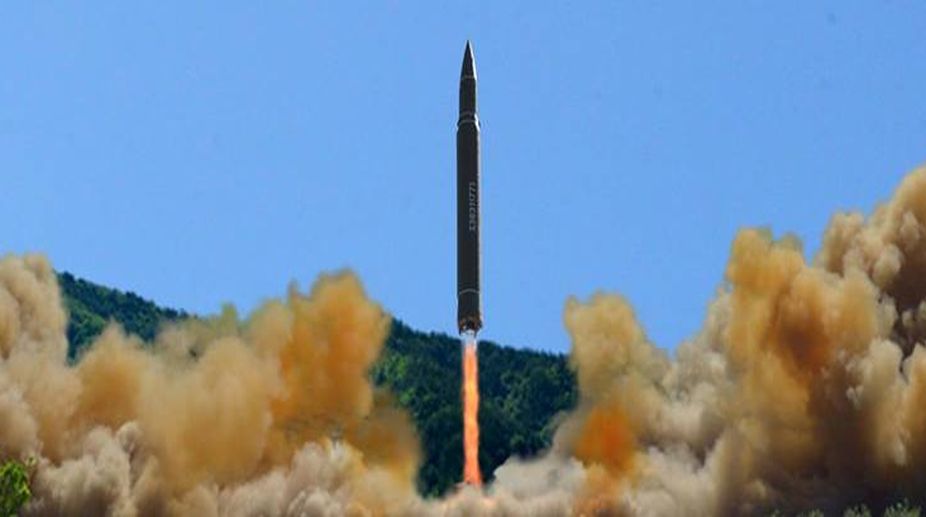The doctrine of nuclear deterrence, put to the test in the standoff between Washington and Pyongyang, dates to the Cold War when the world’s two superpowers seemed hellbent on “mutually assured destruction”.
The arms race between United States and the then Soviet Union saw a proliferation of nuclear warheads as well as their vectors — missiles, planes and submarines.
Advertisement
On the eve of the collapse of the Soviet Union in 1990, the Soviet arsenal boasted some 37,000 warheads, compared with nearly 22,000 warheads in the United States, according to the Bulletin of the Atomic Scientists (BAS).
Today, thanks to a series of multi-lateral and bilateral treaties, those numbers have dropped to around 7,000 and 4,480 respectively — still more than enough to assure nuclear suicide for both sides.
“The nuclear weapon, invented 70 years ago, has shown itself to be an effective means of preventing war since there has been no conflict between major powers since then,” said researcher Bruno Tertrais of the Paris-based Foundation for Strategic Research.
“There has never been open conflict between nuclear powers and no country with nuclear weapons has ever been invaded,” he added in a report.
Similarly, “no country protected by the nuclear umbrella has ever suffered a massive military attack,” he wrote, referring to NATO’s 29 member states.
But critics of the deterrence doctrine reject these arguments, saying it is a theory that cannot be tested.
Moreover, they argue that the interdependence of the world’s economies and the influence of international institutions have been the overriding guarantors of peace between the big powers since World War II.
The policy has faced two serious tests — the 1962 Cuban missile crisis and a hair-trigger confrontation between India and Pakistan 40 years later.
In 1962, at the height of the Cold War, an American spy plane detected Soviet medium-range ballistic missile installations on the territory of Soviet ally Cuba just miles off the Florida coast.
The Soviet move followed the deployment of American ballistic missiles in Italy and Turkey.
The US president John F. Kennedy responded with a military blockade of Cuba and placed US strategic forces on maximum alert dubbed DEFCON 2, the level preceding full-out nuclear war.
B-52 bombers were on continuous airborne patrol and dozens of inter-continental ballistic missiles (ICBMs) were on ready alert.
Soviet ships laden with nuclear missiles turned back in exchange for a secret agreement by Washington to remove its missiles from Turkey.
Washington also promised not to invade Cuba.
The crisis prompted the BAS to move its “Doomsday Clock” to two minutes before midnight, the closest the world has ever been to global nuclear catastrophe in its estimation.
Four decades later India and Pakistan came to the brink of nuclear war as their decades-old dispute over Kashmir reached fever pitch, with nearly a million soldiers massed on either side of the territory’s disputed border.
Both became a nuclear power in 1998.
After Pakistan’s then president Pervez Musharraf said he was prepared to resort to nuclear weapons against India, India’s defence minister told the International Herald Tribune that “he should realise that India can survive a nuclear attack, but Pakistan cannot.”
The two sides began a series of tit-for-tat missile tests before agreeing, under US pressure, to de-escalate tensions.
They reached a ceasefire in November 2003 and started a dialogue the following January.
International relations expert Daniel Vernet, former editor-in-chief of the influential French daily Le Monde, said the crisis involving North Korea illustrates the dangers of nuclear proliferation.
“Dissuasion worked as long as there were few actors and they were considered rational,” he said in a recent op-ed.
“Their proliferation increases the possibility for misunderstandings, false interpretations of another’s intentions, or unbalanced judgement in autocratic regimes.”
The BAS set its Doomsday Clock to two and a half minutes to midnight in January this year partly as a result of a Trump’s “comments over North Korea, Russia and nuclear weapons.”











